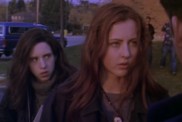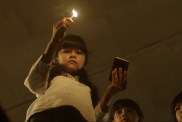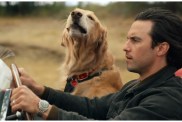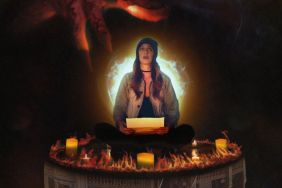
Filmmaker Peter Stricklands last movie, Berberian Sound Studio was a loving homage to both giallo, as well as to the insular art of sound design. His latest film The Duke of Burgundy pays similar homage to cult movies of the 70s with its look at an unconventional relationship between Cynthia (Sidse Babett Knudsen), an enthusiast of entomology (i.e. the study of insects), and her housemaid Evelyn (Chara DAnna, who also appeared in Berberian).
At first, this seems like it could be a fairly straight-forward employer-employee relationship. Evelyn performs mundane house chores, as Cynthia finds her cleaning skills lacking. Punishment follows, and that punishment veers into sexual territory, as a romantic bond is revealed, as is Evelyn’s true hold over the proceedings.
While Burgundy is not a horror film persé, it delves heavily into the realm of 70s genre film, with a lavish period look that may remind some of movies like Harold and Maude, The Omen and more esoteric works from Jess Franco. The result is a film that’s equally as gorgeous and hypnotic as it is shocking.
Shock Till You Drop spoke with Strickland when he returned to New York City last week, unaware that the British filmmaker behind such distinctive European films actually has a history with the citys cinema underground. We also discovered that when you speak to Strickland you should prepare to have your mind blown with obscure references about the inspiration for his distinct films.
Shock Till You Drop: I was curious about your background, since your movies have such a distinctive look and feel to them. Did you do other films before Berberian Sound Studio?
Peter Strickland: Berberian is my second feature. My first one didnt get distribution in the States. My first one we shot in Romania in 2006 actually but it never made it over to America but prior to that, I had been making films seriously since 1992. I did some fringe theater then and I did some super 8 work and my first public showing was in 1993 at the London Filmmakers Co-op and through the Filmmakers Co-op I met Vivian Dick who is an American filmmaker who worked with Lydia Lunch. She wouldnt remember me but I connected with the New York Filmmakers Co-op, which is M. M. Serra, who interestingly enough makes movies with women and masochism and sadismsadism is too strong a wordwith John Zorn doing the soundtrack. I met people like (photographer) Ethan Mass through her, and I did my first proper 16 mm narrative short film in New York 20 years ago with Nick Zedd, who was from the cinema of transgression. I think hes gone to Mexico now, the last I heard. Holly Woodlawn who was in Paul Morrisseys Trash, so I guess a lot of my background was from the underground cinema. It was a mixture of American underground cinema and European stuff like Bunuel, Fassbender, but I was obsessed with the American underground, particularly Jordan Belson, Stan Brackhage, Jack Smith. I was very lucky to know Taylor Mead back in the 90s because he passed away a few years ago.
I grew up in a town called Reading where you couldnt really see those films so Id read about them from books like Film as a Subversive Art, Midnight Movies, the Hoberman/Rosenbaum one, Danny Pearys Cult Movies and actually it wasnt until I went to Kims Video on St. Marks that I could actually see most of these films. You couldnt even see El Topo in the UK. Kims had this VHS with the genitals kind of pixelated because they had some kind of Japanese bootleg, but I got into the Cinema of Transgression through Kims Video and Tommy Turner. He was a big influence.
Shock: How much time did you spend in New York?
Strickland: Quite long periods because I happened to have an auntwell, shes left New York nowbut she lived in Woodhaven. So I stayed with my aunt and Id just take the J train into Manhattan and just grab VHS tapes and see all the films I couldnt see in the UK. So that was an amazing time for me and that was the first time I actually got to know people in that world. When you were a kid, you just think everyone is born into it and its an impenetrable world, but you realize that just the same, they could have started living in towns the thing that I got from that movement was that they just did it themselves. No one is going to help you, and I learned that with my first feature film, which I shot in Romania. No one is going to help me. Just do it. Pick up a camera. Its not cheap, but it took me five years to make that film and that was the only way to get noticed really. Short films, you kind of got notice but not enough for someone to trust you to do a feature film. Theyd pat you on the back. Well done. Thank you for that.

Strickland: Yeah, a huge part. I shot my first film at the Millennium Cinema toilets on East 4th Street, Howard Guttenplans cinema, I guess its gone? I remember Mike Kusha, he was editing his stuff there. [Note: After this interview, we double-checked and the Millennium still exists!]
Shock: As far as your entry into this movie, I was reading about the influence of Jess Franco, whose work I dont really know at all.
Strickland: Dont worry too much about that. (chuckles)
Shock: I know, but you watch your movies and then you read what some of the influences are and it makes you want to seek some of them out.
Strickland: Pick carefully. Theres some really bad ones out there.
Shock: As far as that influence and some of the subject matter of the film such as butterflies and insects and how you connect that to the relationship at the core of the film. Did one of these ideas come to you first and things went from there?
Strickland: The main thing was the sexploitation, that was #1. I really wanted to do something that came from that world. I really loved those sleazy films, I think theyre great. Theres some bad ones as well and there are some ones with some very dubious sexual politics but the good ones are really, really special, and I think they need to be seen. What was interesting about them was to get them funded all they had to do was have five or six sex scenes and then they were kind of left on their own after that. No notes, no committee. Just do what you want as long as you have the sex in there. So what you find is that in between you have these incredibly lyrical askew moments which are unlike anything else in cinema. I dont know if theyre by design or by accident, but that specific period of Jess Franco around the early 70s, that fantastical period. There are moments that are almost like Georges Franju, the director of Eyes without a Face. I really loved that atmosphere and I wanted to cling onto it and take some of those elementsfemale lovers, sadomasochism, fantastical elementsbut not by design. I think organically the film ended up very different from a Jess Franco film. That was just a beginning to set me off on sail, and then when you write, other things come into it. It takes on its own life when you start writing, but I always feel I need to push, push against something sometimes as well. I like the idea of rules. Genre gives me that. It gives me that framework to within or work against, so thats what I find really exciting about working in genre. I dont really want to do a pastiche.
Shock: You just mentioned genre, but at its core, its really just a relationship movie about these two women and their relationship. Though, there are moments that are genre and more experimental, like the dream sequence.
Strickland: Yeah, but thats whats interesting. When I finished the script, its not like a Franco film in the end. It starts off, maybe the first ten minutes, is like those August House of Shame films where youre inside a sexual fantasy. The Ice Queen, the wicked warden, that kind of stuff, who everyone wants to get off on, but once that reveal happens, thats a wig and that she doesnt enjoy urinating on someone, but it goes into a very different area, which is about people who have different intimate needs and it doesnt matter what that need is. It can be the most basic sexual act, but if one person finds it distasteful or repellent, but youre involved with someone who is compromising, either the one that goes along with it to please the other one or the one who is withholding their desires to give the other one some piece.
I dont know the answer to that. But really, for me, if somebody asked me, What is this film? Id say its a domestic drama. Its some window dressing to it. For me, it is a tender film, its sensual, but this is whats interesting to me. Its consent but with a question mark, because obviously it veers into compromising [places]it veers into coercion. Thats where it gets interesting. I didnt want to do a film where theyre both into that game, because its just kind of boring. Thats harmony. I want to find some discord that one of them is suffering somewhat, because she cant get what she needs.
Shock: When you start watching the movie, you assume its going to be a master-servant relationship where Chiara will just do whatever shes told
Strickland: Thats what I wanted, yeah.
Shock: But that relationship changes and evolves, which does have that connection to insects that change from one form to another. There are some parallels to that, even if the insects seem to be a separate thing.
Strickland: Yeah, I wasnt trying to ram that in. Its more of a framework. Its more of a sensuality that I wanted to add. It is this other texture. The film is so much about texturethe underwear, the leaves falling down. Its not for me to say, Is this erotic? Is it anti-erotic? but I can see it as a sensual film and I think the insects add something to that. Yeah, Im aware that there are some parallels that you can find, but out of all the concerns, the sex didnt really bother me. The thing that bothered me the most is that I dont want to force down any metaphor into the audience. I dont want to worry about it. I just always like to I almost said go with the flow.

Shock: I was curious how much research you had to do into either of those worlds, whether its the world of S&M or into the insects. I assume you did have some live insects you were using?
Strickland: No, not at all. They all were loaned from an entomology institute in Budapest. We didnt kill anything, thank God, but the live ones wereyoure going to hate me, but they were digital.
Shock: But I assume youd have to do some research to know how they move.
Strickland: Yeah, research is always a tricky one. I did more research on the insects than on the sadomasochism. Sadomasochism, there are so many different types. I think some would argue that Evelyns masochism isnt real masochism because shes genuinely punished when the pajamas come on. Its too hard for it to handle, but if you look at films such as Martha by Fassbinder, thats real masochism and thats something that goes beyond this very safe area, which has safe words and so on. Its a very difficult film to watch. Again, I think being around certain filmmakers in the 90s in New York, I think that kind of stuff was happening all the time. It was almost abnormal not to be into it. So yeah, it was just very common in terms of the films being made. My first proper film job, and not as a director, but as in working on set, was Bruce LaBruce on Skin Flick which is probably his most sadomasochistic film, so I dont know why this came out now. I think stuff kind of stays in you and just sort of bubbles up and again. Franco I had only seen quite recently, but Bunuels Belle de Jour I had seen years ago, but that was a big influence on the film. Its weird having things just kind of come up.
Shock: Im curious about creating the look and feel of your films. How do you work with your collaborators to create this effect?
Strickland: I think I choose people who know that period, both musically and visually. So, Nick Knowland, hes in his 70s. He shot John Lennons Imagine. Hes worked all through the 70s, so hes got that eye, and its interesting with Nick because we used the Alexa, so were obviously not using film.
Shock: Which is pretty amazing because I wouldnt knowthat.
Strickland: Yeah, there is the option of using various effects to give it this distressed look [chuckles], this bleached look, but we didnt want to do that. We just thought we were going to try some things, but lets not push it too much or otherwise it feels a bit retro. I think what Nick did is he always had a haze machine on him, which really gave it a certain softness. I think the scenes where Evelyn is getting a bit excitable, he was using a lot of bevels and mirrors in front of a lens, so you had this very organic in-camera position which really gave it its heightened feel. In terms of the music of Cats Eyes, I mean Rachel and Faris are obsessed with music from that period, more like American girl pop.
Shock: Did they come together just to do the music for this?
Strickland: No, they did an album prior to that in 2011. Its called Cat’s Eyes, thats the name of the album. Its one of the best things Ive heard in years. I can tell you what I did feel in that albumthis is just me as a listener, Im not saying they designed it that wayis The Carpenters. They were the first band, apart from Sonic Youth, to take the Carpenters without any irony or pastiche. They did something incredibly beautiful, and I think if Karen Carpenter were working now, it would be like that. It was really modern as well, but I think theyre incredibly talented and I was truly, truly honored when I offered them the script and asked if they would consider this, and luckily, they said, Yes. And then it was a question of because its got these girl pop moments, but its got these rock and roll moments. Rachels a classical musician, so we spoke a lot about the instruments that youd hear at that time in the 70s, so you wouldnt hear that much string. Youd maybe hear woodwinds, so the Cor Anglais, cello was a very important thing.
Shock: Did you know they were obsessed with this music before you contacted them?
Strickland: I read interviews with them and I knew Rachel was a classical musician and she could play a lot of those instruments. So we made a few references to start us off in terms of the mood, like Nilssons Everybodys Talking from Midnight Cowboy. That was just the mood I needed for the beginning credits. Something quite upbeat, but still had a certain foreboding melancholy to it. Then Rachel and Faris did this thing and I really loved it. What was interesting is that they didnt do a pastiche. They had these string sections, but they manipulated them with effects to make them sound like synthesizers, so like any good soundtrack, I hope the soundtrack lives its own life because there are so many soundtracks that I buy without having seen the film. For me, that would be an amazing thing, if it had its own life beyond that. Obviously, if people watch the film on top of that its a good thing
Shock: Are there any plans to release the soundtrack separately?
Strickland: Its coming out. February 16.
The Duke of Burgundy opens in select theaters on Friday, January 23.









